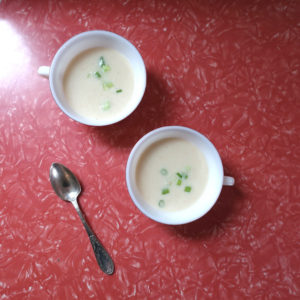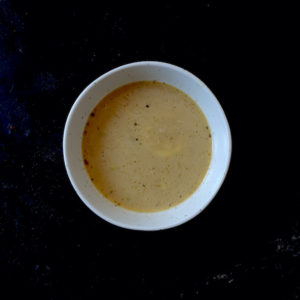Soups Without Recipes
There is nothing like soup. It is by its nature eccentric: no two are ever alike, unless of course you get your soup from cans.
Laurie Colwin, “Soup”, Home Cooking

Even we are exhorted to hoard every leftover scrap of food to craft innovative meals in a thrifty cycle of reduce, reuse, recycle, I find myself unskilled at this type of cooking. When I open the fridge to a view of dribs and drabs of a dozen dishes, I am not so much inspired as tired.
This is a not a politically correct admission. Not that it matters. I may not be observant, but when it comes to guilt, I am indeed a daughter of Israel. Throwing out perfectly good food throws me into fits of self-laceration.
Meaning those dribs and drabs need to somehow be eaten.
In An Everlasting Meal, Tamar Adler suggests cooking a large pot of rice, heating your leftovers, and calling it a “rice meal.” An admirable idea. Sandwiches can be an effective mopping-up exercise, too. There’s always pasta.
Most often, though, those plastic containers get labeled, dated, and frozen. Their eventual destiny is the soup pot. There they join piles of bones, along with any meat still helpfully clinging to them. The fridge gets scanned for vegetables. I rummage and pick over, peel and chop and sort. Everything goes into the pot, which simmers all afternoon.
A few months ago I made soup from leftover chicken bones (actually, the chicken bones were from chicken with radishes and parsley sauce), marrow bones sold cheaply as “soup bones,” leftover parsley, garlic, shallot, turnip greens, ham, and carrots. During the last two hours of cooking I added a half cup each of red lentils and risotto rice. The risotto rice isn’t much good for risotto making, refusing to soften for the iconic dish. But it does very well in soup.
An especially fine soup arose from bacon, two meaty pork chops and their mustard sauce, half a chorizo link, a leek, a turnip, a rutabaga, some fresh cranberry beans past their prime, and the final flat dregs of a bottle of Cava.

—
In Soup: A Way of Life, Barbara Kafka has a section helpfully entitled “Vagueness.”
Soup is also easy in that it is rarely demandingly exact. A little more or a little less of an ingredient will not ruin the dish.
This does not mean soup is a dumping ground for vegetables near death. Nor is it opportunity to make what my grandmother called “hetcha-petcha.” You want the end result to be palatable–and digestible.
If you are wondering whether your ingredients will play well together,”taste” them in your head. Still unsure? Mix a little in a small dish. Do the flavors work together? Remember ingredients will meld; onion will soften, raw potato will cook. Does it need salt? lemon? vinegar? tomato paste? Try adding a little of the lacking seasoning. Don’t be afraid to play around. You’re doing this in a small dish, not the entire pot.
—
Last night’s soup, which indeed is tonight’s soup, came from three icy Pyrex storage containers. The first held some leftover beef broth from Corned Beef after Jane Grigson. The second had meaty oxtail bones. The third contained a goodly hunk of chuck roast.
I piled all this on the counter to defrost and searched the fridge, coming up with fresh garlic, a leek, two halved onions (not one…two), celery, and one usable carrot. Hopes of sweating the vegetables in butter were dashed by real life. Throwing everything into the pot, I added salt, pepper, a bay leaf, a few glasses of water (a sophisticated measure), poured in a little Armagnac, and simmered for three hours.

The oxtails and chuck were extremely fatty–frankly, disgustingly gelid. Remembering a Paula Wolfert trick, I fetched The Cooking Of Southwest France down from the shelf–I know, I never shut up about that book–and looked up “double degreasing.” I’d never done it before. The process:
–Strain solids into a colander set over a bowl. Returned broth to the pot.
–Set the pot half on, half off the burner. Bring the broth to a low boil. Fat will collect on the cool side. Skim it off. This takes 20-30 minutes, but with a dish like this, it’s time well spent. Wolfert says your sauces will be “satiny.” A fine adjective. What they won’t be is fatty.
Returning to our strainer: I thought the meat would be tasteless after time in the freezer topped by hours on the stove. But I was wrong; it was still nicely flavorful. I picked out the bones and gristle, made sure everything was bite-sized, and added it back to the broth, which needed salt. I added a couple peeled, diced potatoes and a little tomato paste. Honestly? It was better than I expected.
My point here is less (throat clearing, harrumphing) “A Recipe” than a good way of putting leftovers to delicious use. A few posts back I mentioned Gabrielle Hamilton’s Mixed Meats Stock With Walk-In Detritus; Hamilton calls hers a “mutt stock.”This soup is analogous in its variability. This isn’t a stock, but it is a mutt, a soup that doesn’t adhere to a specific recipe or fall under any specific title. It’s the soup you make when the freezer’s full or you’ve run out of freezer containers or it’s a good day to have soup. It’s a soup that, made with thought and care, will always be wonderful.
All this said, I can’t offer a recipe so much as tell you what I had, and what I did with it, in the roughest of terms.

Leftover Soup
yield: four servings
prep time: about 4 hours
2 tablespoons unsalted butter
1-2 carrots, peeled and diced
1-2 onions, peeled and diced
1-2 celery stalks, diced
approximately 2-4 pounds meaty beef/oxtail bones and/or chicken bones/chicken necks/giblets (not livers)
approximately 4 cups chicken or beef broth
approximately 2-3 cups water, if needed
1 bay leaf
black pepper
Any mixture of:
leeks, garlic, scallions, shallots
Armagnac or brandy (optional)
tomato paste
salt
to thicken the soup:
potato
1/2 cup rice
1/2 cup red lentils
Place a large soup or stockpot over low heat. Melt the butter. Add onion, carrot, and celery, stirring constantly over low heat until vegetables are softened and translucent, about ten minutes.
Add bones and giblets to the pot. Add the broth and enough water to cover. Add bay leaf and good grinding of black pepper (about 1 tablespoon). Add the Armagnac, if using.
Bring soup to gentle simmer and allowed to cook for three hours. If your soup is fatty, degrease by staining solids in colander placed over a bowl. Return broth to pot. Place pot half on, half off the burner. Bring broth to a low boil and skim the cool side for about 25 minutes.
Pick over meat in colander, removing any bones, cartilage, and gristle. Break remaining meat into bite-sized pieces and return it to the pot. Heat to low.
Taste for salt: likely you need it. Add 2 peeled diced potatoes (or lentils or rice). Bring soup to a simmer again. Cook for another 1-2 hours.
You can mash potatoes with a potato masher for additional texture, if you wish, but take care, as soup is hot. Serve with a dollop of sour cream, yogurt, or eat all by itself. Good bread is essential.





